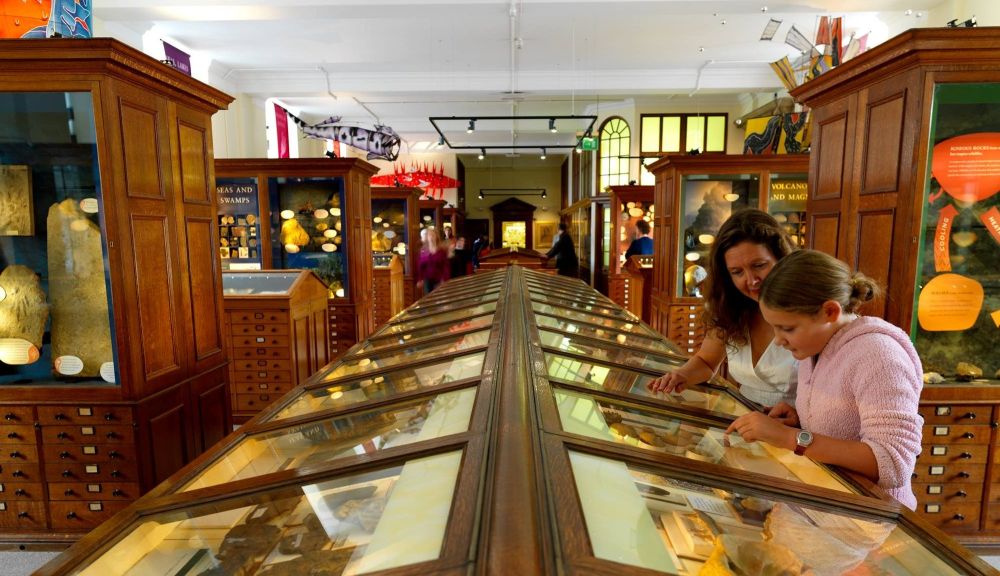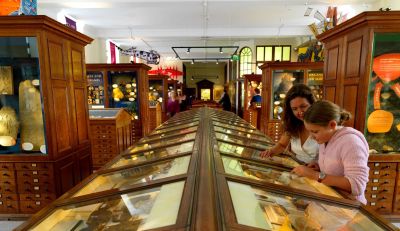

The Fossil Explorers activity is a family-friendly exploration into the world of paleontology tailored for children and adults alike at the Sedgwick Museum of Earth Sciences. During this immersive experience, attendees have the chance to handle ancient fossils and learn about the creatures that roamed the Earth millions of years ago. Museum educators guide participants through the origins, adaptations, and eventual extinction of various species while encouraging questions about natural history and the processes of science. The hands-on aspect of touching real fossils helps to spark curiosity and is a key educational highlight. Additionally, the museum provides activity sheets which allow younger guests to go on a 'fossil hunt' within the exhibits, making discoveries and learning to identify fossil types as they go.
Mineral Magic is an engaging activity designed for visitors with a keen interest in geology. This session at the Sedgwick Museum of Earth Sciences invites participants to discover the incredible world of minerals—naturally occurring crystalline substances that come in an astonishing variety of forms, colors, and properties. Museum educators provide insightful talks on how minerals are formed, their role in Earth's geological processes, and their uses in everyday life. Visitors can examine sample minerals up close, learning about their properties through hands-on investigation. The educational content is enriched with didactic panels and interactive displays, ensuring that attendees of all ages leave with a greater appreciation for the complexity and beauty of Earth's mineral resources.
Darwin's Doodles is an artistic activity session organized by the Sedgwick Museum aimed at combining art with science in an innovative way. Participants follow in the footsteps of Charles Darwin, one of the most famous alumni of Cambridge University, by sketching ancient artifacts and fossils from the museum's extensive collection. With pencils in hand and drawing sheets provided, individuals of all skill levels are encouraged to observe and capture the intricate details of specimens just as Darwin might have done in his own notebooks. The activity is not only a nod to Darwin's scientific legacy, but also a quiet and contemplative way for visitors to engage with natural history. Museum staff are available to provide sketching guidance and discuss the stories behind the exhibits on display.
The Time Walk is a self-guided tour that takes participants on a journey through Earth's vast geological history within the walls of the Sedgwick Museum of Earth Sciences. With the help of a timeline running along the floor of the museum, visitors walk through different geological periods, stopping at various exhibits that showcase significant events in Earth's history. These stops include displays on the formation of the solar system, the rise of multicellular organisms, the age of dinosaurs, and the ice ages. Information posters and interactive screens allow visitors to delve deeper into each period, understanding the environmental changes and evolutionary advances that have shaped our world. This tour underpins the museum's ability to provide a visual and chronological representation of Earth's story, making complex scientific concepts accessible to everyone.
Rocks and Minerals Identification is a practical activity where visitors can bring their own geological finds to the Sedgwick Museum for examination by experts. Ideal for amateur geologists and collectors, participants have the unique opportunity to learn directly from museum curators about the specimens they've discovered. Experts provide insights into identification techniques, geological relevance, and the context of these samples in the natural world. Often this sparks engaging discussions between professionals and enthusiasts, making it an excellent opportunity for knowledge exchange and fostering a deeper appreciation for geology. This interactive experience is not only educational but can also be incredibly rewarding as visitors uncover the stories and origins of their personal collections.
Prehistoric Creatures Puppetry is a captivating activity hosted by the Sedgwick Museum, particularly aimed at younger audiences. This creative session allows children to imagine and recreate the movements and behaviors of ancient animals using a range of puppetry techniques. Utilizing handmade puppets that represent various prehistoric creatures, participants are encouraged to learn about these beings while also expressing themselves artistically. The session fosters an interactive atmosphere where children can engage with the science of paleontology in a new and entertaining way. Museum staff are available to provide fun facts and guidance, ensuring that children not only play but also learn meaningful details about the animals they are animating.
The Earth Science Talks is a series of lectures presented by professionals and academics at the Sedgwick Museum for a general audience. These talks cover a range of topics, from current research to historical perspectives on geology and paleontology. The presenters aim to make their subjects accessible, often including multimedia elements to illustrate complex ideas. For visitors with an intellectual curiosity about earth sciences, these talks serve as an excellent forum for education and discussion. Following the presentations, there is usually a Q&A session, where attendees have the chance to ask questions and explore topics in greater depth. This activity provides a deeper understanding of the scientific processes that have shaped our planet and continues to influence it today.
The Historic Cambridge Geology Tour is a guided walk around Cambridge, launched from the Sedgwick Museum, that reveals the hidden geology of this ancient university town. Participants trek through historic cobblestone streets and encounter buildings adorned with a variety of stones that each tell a story. A knowledgeable guide dives into the relationship between the architectural richness of Cambridge and its geological underpinnings. From the use of local clunch stone to imported marbles, each stop highlights the connection between the city's growth and the resources the Earth provides. This outdoor activity not only educates about local geology but also about the impact of human activity on the natural world throughout history.
